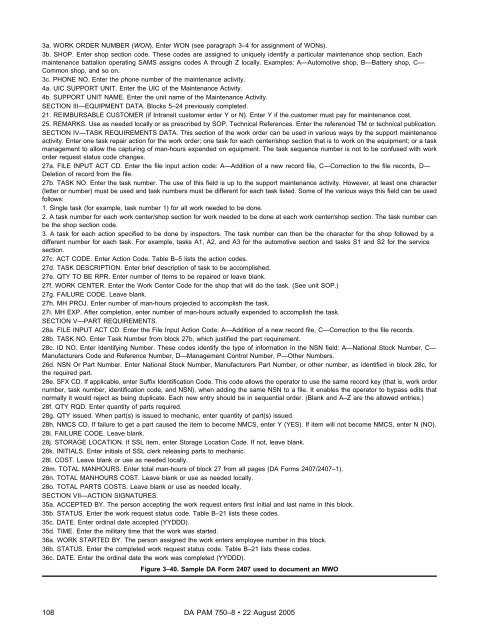The Army Maintenance Management System (TAMMS) Users Manual
The Army Maintenance Management System (TAMMS) Users Manual
The Army Maintenance Management System (TAMMS) Users Manual
Create successful ePaper yourself
Turn your PDF publications into a flip-book with our unique Google optimized e-Paper software.
3a. WORK ORDER NUMBER (WON). Enter WON (see paragraph 3–4 for assignment of WONs).<br />
3b. SHOP. Enter shop section code. <strong>The</strong>se codes are assigned to uniquely identify a particular maintenance shop section. Each<br />
maintenance battalion operating SAMS assigns codes A through Z locally. Examples: A—Automotive shop, B—Battery shop, C—<br />
Common shop, and so on.<br />
3c. PHONE NO. Enter the phone number of the maintenance activity.<br />
4a. UIC SUPPORT UNIT. Enter the UIC of the <strong>Maintenance</strong> Activity.<br />
4b. SUPPORT UNIT NAME. Enter the unit name of the <strong>Maintenance</strong> Activity.<br />
SECTION III—EQUIPMENT DATA. Blocks 5–24 previously completed.<br />
21. REIMBURSABLE CUSTOMER (if Intransit customer enter Y or N). Enter Y if the customer must pay for maintenance cost.<br />
25. REMARKS. Use as needed locally or as prescribed by SOP. Technical References. Enter the referenced TM or technical publication.<br />
SECTION IV—TASK REQUIREMENTS DATA. This section of the work order can be used in various ways by the support maintenance<br />
activity. Enter one task repair action for the work order; one task for each center/shop section that is to work on the equipment; or a task<br />
management to allow the capturing of man-hours expended on equipment. <strong>The</strong> task sequence number is not to be confused with work<br />
order request status code changes.<br />
27a. FILE INPUT ACT CD. Enter the file input action code: A—Addition of a new record file, C—Correction to the file records, D—<br />
Deletion of record from the file.<br />
27b. TASK NO. Enter the task number. <strong>The</strong> use of this field is up to the support maintenance activity. However, at least one character<br />
(letter or number) must be used and task numbers must be different for each task listed. Some of the various ways this field can be used<br />
follows:<br />
1. Single task (for example, task number 1) for all work needed to be done.<br />
2. A task number for each work center/shop section for work needed to be done at each work center/shop section. <strong>The</strong> task number can<br />
be the shop section code.<br />
3. A task for each action specified to be done by inspectors. <strong>The</strong> task number can then be the character for the shop followed by a<br />
different number for each task. For example, tasks A1, A2, and A3 for the automotive section and tasks S1 and S2 for the service<br />
section.<br />
27c. ACT CODE. Enter Action Code. Table B–5 lists the action codes.<br />
27d. TASK DESCRIPTION. Enter brief description of task to be accomplished.<br />
27e. QTY TO BE RPR. Enter number of items to be repaired or leave blank.<br />
27f. WORK CENTER. Enter the Work Center Code for the shop that will do the task. (See unit SOP.)<br />
27g. FAILURE CODE. Leave blank.<br />
27h. MH PROJ. Enter number of man-hours projected to accomplish the task.<br />
27i. MH EXP. After completion, enter number of man-hours actually expended to accomplish the task.<br />
SECTION V—PART REQUIREMENTS.<br />
28a. FILE INPUT ACT CD. Enter the File Input Action Code: A—Addition of a new record file, C—Correction to the file records.<br />
28b. TASK NO. Enter Task Number from block 27b, which justified the part requirement.<br />
28c. ID NO. Enter Identifying Number. <strong>The</strong>se codes identify the type of information in the NSN field: A—National Stock Number, C—<br />
Manufacturers Code and Reference Number, D—<strong>Management</strong> Control Number, P—Other Numbers.<br />
26d. NSN Or Part Number. Enter National Stock Number, Manufacturers Part Number, or other number, as identified in block 28c, for<br />
the required part.<br />
28e. SFX CD. If applicable, enter Suffix Identification Code. This code allows the operator to use the same record key (that is, work order<br />
number, task number, identification code, and NSN), when adding the same NSN to a file. It enables the operator to bypass edits that<br />
normally it would reject as being duplicate. Each new entry should be in sequential order. (Blank and A–Z are the allowed entries.)<br />
28f. QTY RQD. Enter quantity of parts required.<br />
28g. QTY issued. When part(s) is issued to mechanic, enter quantity of part(s) issued.<br />
28h. NMCS CD. If failure to get a part caused the item to become NMCS, enter Y (YES). If item will not become NMCS, enter N (NO).<br />
28i. FAILURE CODE. Leave blank.<br />
28j. STORAGE LOCATION. If SSL item, enter Storage Location Code. If not, leave blank.<br />
28k. INITIALS. Enter initials of SSL clerk releasing parts to mechanic.<br />
28l. COST. Leave blank or use as needed locally.<br />
28m. TOTAL MANHOURS. Enter total man-hours of block 27 from all pages (DA Forms 2407/2407–1).<br />
28n. TOTAL MANHOURS COST. Leave blank or use as needed locally.<br />
28o. TOTAL PARTS COSTS. Leave blank or use as needed locally.<br />
SECTION VII—ACTION SIGNATURES.<br />
35a. ACCEPTED BY. <strong>The</strong> person accepting the work request enters first initial and last name in this block.<br />
35b. STATUS. Enter the work request status code. Table B–21 lists these codes.<br />
35c. DATE. Enter ordinal date accepted (YYDDD).<br />
35d. TIME. Enter the military time that the work was started.<br />
36a. WORK STARTED BY. <strong>The</strong> person assigned the work enters employee number in this block.<br />
36b. STATUS. Enter the completed work request status code. Table B–21 lists these codes.<br />
36c. DATE. Enter the ordinal date the work was completed (YYDDD).<br />
Figure 3–40. Sample DA Form 2407 used to document an MWO<br />
108 DA PAM 750–8 22 August 2005

















